Originally prepared for Vegetable MD Online by Thomas A. Zitter.
This page includes symptoms caused by:
Bacteria
Bacterial Wilt
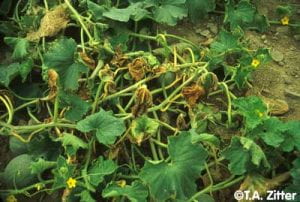
Symptoms: Wilt initially affecting single leaves, starting as yellowing and then death of tissue between main veins, while veins themselves remain green in color. Wilt progresses to individual runners of a plant. Cut stem, squeeze sap from cut ends, put 2 pieces together, then slowly pull them apart while looking for characteristic thin strands of sticky bacterial material. Strands do not always form, so repeat several times until seen. Cucumber beetles often present (or previously) on leaves or in flowers.
Cucurbit Yellow Vine Decline
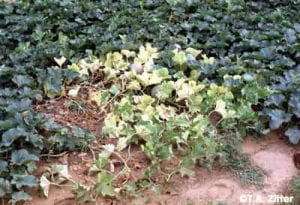
Symptoms: Vines wilt and turn yellow in several days. Cross-sectioning of the stem will likely reveal a yellow discoloration of the phloem tissue which has become colonized by the bacteria.
Fungi & Oomycetes
Anthracnose | See factsheet for more information (LIHREC)
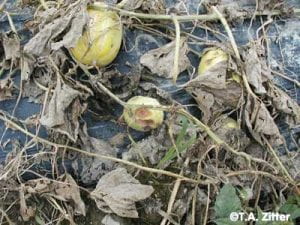
Symptoms: The circular leaf spots are initially water-soaked, then become yellow to tan. Round, black, sunken spots can develop on fruit. Whole leaves and vines can decline and turn necrotic.
Fusarium Crown Rot | See factsheet for more information (LIHREC)
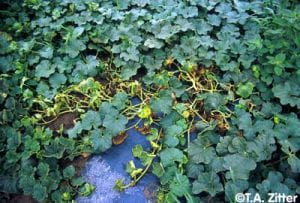
Symptoms: Wilt initially affecting single runners of a plant. Crown may be girdled. Distinctive dark brown decay a base of stem, with white or pinkish fungal growth, becomes soft and mushy. Yellow, orange or brown discoloration in water conducting tissue at base of plant. Fruit rot also. Localized occurrence in field and in region.
Gummy stem blight | See factsheet for more information (LIHREC)
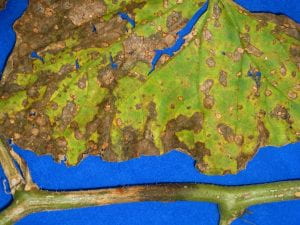
Symptoms: Leaf spots are initially round or triangular when beginning at the leaf margin. They can rapidly enlarge and become irregular. Color is tan to brown. When seedling stems are infected the tissue often appears water-soaked and can lead to girdling which kills the plant. Petiole and stem tissues affected on older plants are water-soaked, tan, and develop a characteristic reddish brown gummy exudate. Tiny black specks, which are the pathogen’s fruiting bodies, develop on infected plant tissue including fruit.
Phytophthora crown rot | See factsheet for more information
Symptoms: Wilting and rapid plant decline. Vine collapsed and brown. Starts in areas with poor drainage after soil was saturated with water. Fruit rot also. Dark leaf spots occur rarely. Localized occurrence in field and in region.
Plectosporium | See factsheet for more information (LIHREC)
Symptoms: Characteristic symptom is the diamond to spindle shaped white-tan dry and scabby lesions which are most distinctive on leaf veins and petioles, contrasting with the symptomless leaf tissue between veins. Lesions also form on vines, stems, petioles, fruit handles, and sometimes fruit.
Powdery Mildew | See factsheet for more information
Symptoms: White, talcum-like, powdery fungal growth develops on both leaf surfaces and on petioles and stems. Symptoms usually develop first on older leaves, shaded lower leaves, and lower leaf surfaces. Powdery spots on lower surfaces may have yellow spots opposite on the upper leaf surface. Field-grown plants become susceptible when producing fruit or stressed. Infected leaves and plants senesce prematurely.
Scab
Symptoms: Brown spots, angular in shape (restricted by small veins), often with yellow haloes. Young spots are pale-green and water-soaked. Older spots have holes in center. Angular leaf spot causes similar symptoms. Symptoms also occur on petioles, stems and fruit.
Phytoplasmas
Aster yellows
Symptoms: Yellowing of young leaves, proliferation of secondary shoots, and rigid, erect growth habit. Fruit symptoms also present. Uncommon.
Viruses
Cucumber Mosaic Virus | See factsheet for more information (LIHREC)
Symptoms: Leaves mottled, distorted (sometimes fern-like), wrinkled, curled, dwarfed. The whole plant may be stunted.
More information/prepared by:
- For more information, please contact:
Meg McGrath – mtm3@cornell.edu & Chris Smart – cds14@cornell.edu


